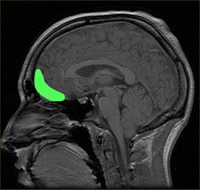Orbitofrontal cortex 🧠

The orbitofrontal cortex (OFC) is a cortical segment found near the eye socket, or orbit. Through its rich connections with the limbic system, the orbitofrontal cortex is the apex of the limbic system—it serves as its mission control room. In normal circumstances in a mature human being, the orbitofrontal cortex is among the highest arbiters of our emotional lives. It receives input from all the senses, which allows it to process environmental data such as vision, touch, taste, smell, and sound. it’s job is to evaluate the nature and potential value of stimuli—based not only on present information but also in light of previous experience.
The neurological traces of early, formative events are embedded in the orbitofrontal cortex, which, in turn, is connected with the hippocampus, for example, a smell that in early memory is associated with a pleasurable experience will likely be judged by the orbitofrontal cortex in a positive way. Through its access to memory traces, conscious and unconscious, the orbitofrontal cortex “decides” the emotional value of stimuli—for example, are we intensely drawn to or repelled by a person or object or activity, or are we neutral? It is constantly surveying the emotional significance of situations, their personal meaning to the individual. Through processes we are not consciously aware of, in microseconds the orbitofrontal cortex decides our take on people or on a situation. Since our likes and dislikes strongly influence what we focus on, the orbitofrontal cortex helps us decide to what or whom we should devote our attention at any given moment. The orbitofrontal cortex contributes to decision making and to inhibiting impulses that, if allowed to be acted out, would be harmful—for example, inappropriate anger or violence. The OFC is also linked to our capacity to balance short-term objectives against longer-term consequences in the process of decision making.
The OFC—particularly in the right hemisphere—has a unique influence on social and emotional behaviors, including attachment relationships. It is deeply concerned with the assessment of interactions between the self and others and plays a ceaseless (but fundamentally life-essential) game of “Who loves me, who loves me not?” It even gauges “How much do they love me or dislike me?” While the explicit meanings of words spoken are decoded in specialized portions of the left hemisphere, the right OFC interprets the emotional content of communications—the other person’s body language, eye movements, and tone of voice. One cue the OFC watches for is the size of the other’s pupils: in social interactions, especially in eyes set in a smiling face, dilated pupils mean enjoyment and delight. Babies are highly sensitive to such cues—as are aphasiac adults (people who, usually due to a stroke, have lost the ability to understand spoken language).
References
- Mate, Gabor. (2010). In the Realm of Hungry Ghosts Close Encounters with Addiction Chapter 16. Like a Child Not Released (p. 216). Berkeley, CA: North Atlantic Books.
Metadata
Type:🔵 Tags: Biology / Neuroscience / Anatomy / Neuroanatomy Status:☀️